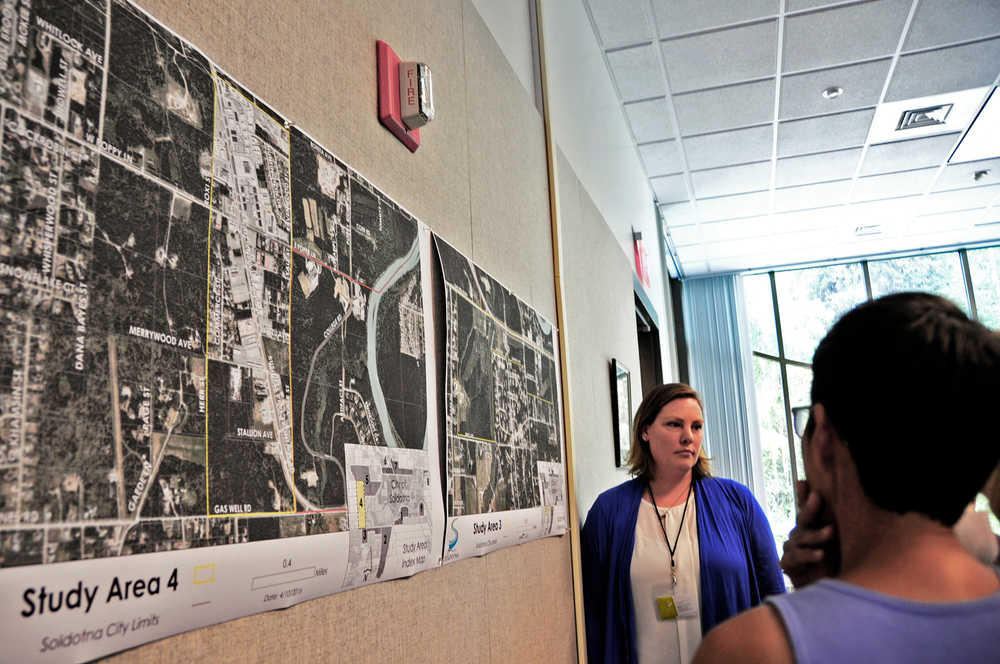The public got a chance to weigh in on the city of Soldotna’s initial annexation study at an open house Thursday.
The city has been debating whether to annex some areas currently outside the city and, if so, where. Soldotna City Council commissioned economic analysis firm Northern Economics to conduct a fiscal impact study of annexation for the city, agreeing to pay $50,000 for the study in July 2015.
The analysis, dated May 2016 but released to the public June 13, provides analyses of nine proposed annexation areas, which encircle Soldotna and include a variety of different types of land, from largely rural with a few residences to the entire business corridor along Kalifornsky Beach Road. Most of the report details how much the city could collect in sales and property taxes in the proposed areas
Large maps of the proposed areas for annexation hung on the walls at the Don Gilman River Center on Funny River Road Thursday night so residents could see exactly what was in each proposed area. Around 4 p.m., when the open house was scheduled to begin, about 10 people peered at the maps and put questions to the three city representatives who hosted the meeting.
Sharon Tyone, who said she has lived on Poppy Lane for 20 years, is concerned about the use of all-terrain vehicles if the city annexes some of the K-Beach area. The city of Soldotna’s municipal code does not allow anyone to drive ATVs or other off-road vehicles, such as snowmachines, within city limits on public or private property without the express consent of the owner.
Many people use their ATVs to go to the businesses along the business corridor in the K-Beach area, Tyone said. Even those who, like her, do not live in an area proposed for annexation but abut one, will be affected by the move, she said.
“If a kid rides his ATV to the gas station on the corner, he won’t be able to do that because you can’t drive an ATV in Soldotna,” Tyone said. “…It’s going to impact all of us.”
Poppy Ridge Road resident Joan Corr, who lives in one of the areas proposed for annexation, said she was concerned that if some of the lands incorporated are rezoned to residential, the taxes would increase and people might not be able to pay the bills. She said she was also concerned that some people would have city water and sewer routed to them without their permission and be stuck with the bills.
“I see that as a tool to take your land,” Corr said. “You cannot afford the taxes… when the rezone to residential.”
City Planner John Czarnezki said the city has heard similar concerns often and has tried to answer some of them on its website. The ATV concern is a common one city officials have heard, as well as concerns about animal licensing. Depending on the zoning, farm animals can be kept within city limits, he said.
The meeting Thursday night was the beginning of what could be a one- to two-year process, he said.
Next comes more public engagement with residents of the proposed annexation areas as well as City Council review before the city would submit a petition to the state’s Local Boundary Commission to officially annex an area.
“One of the things (the City Council) would do is … sit down and try to understand completely where the issues are,” Czarnezki said.
One of the things the city’s administration plans to look at in the next several years is the development of more types of zones, including more mixed-used zones, as part of its comprehensive plan. Although the areas proposed for annexation may be different than the more dense development in downtown Soldotna, different types of zones could accommodate them, he said.
One additional concern is that those in the areas proposed for annexation do not get a vote or representation in the process because they are not part of the city.
Steve Wright, who said he lives outside the areas currently proposed, said it was unfair for those who would be affected to not have a voice.
“The borough residents that live outside the city are affected by this, but we have no representation,” Wright said. “We have no vote.”
There are currently no additionally scheduled public meetings on the annexation analysis.
Once the city submits a petition to the Local Boundary Commission and it is returned, the city must give public notice and the petition must be made available for public review.
Either the city or the Alaska Department of Commerce, Community and Economic Development — the overseeing body of the Local Boundary Commission — must host another public meeting before developing a final report, and then the Local Boundary Commission must host public hearings after that.
Once the Local Boundary Commission has approved it, the Legislature must approve it.
Reach Elizabeth Earl at elizabeth.earl@peninsulaclarion.com.

